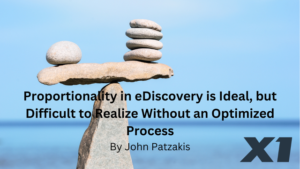
Proportionality-based eDiscovery is a goal that all corporate litigants seek to attain. Under Federal Rule of Civil Procedure 26(b)(1), parties may discover any non-privileged material that is relevant to any party’s claim or defense and proportional to the needs of the case. Litigants that take full advantage of the proportionality rule can greatly reduce cost, time and risk associated with otherwise inefficient eDiscovery.
While there is a keen awareness of proportionality in the legal community, realizing the benefits requires the ability to operationalize workflows as far upstream in the eDiscovery process as possible. For instance, when you’re engaging in data over-collection, which in turn incurs extensive labor and processing costs, the ship has largely sailed before you are able to perform early case assessments and data relevancy analysis, as much of the discovery costs have already been incurred at that point. The case law and the Federal Rules provide that the duty to preserve only applies to potentially relevant information, but unless you have the right operational processes in place, you’re losing out on the ability to attain the benefits of proportionality.
A detailed legal analysis was provided highlighting the case of Raine Group v. Reign Capital, (S.D.N.Y. Feb. 22, 2022), which applied proportionality at the point of identification and collection, not just production. The court endorsed the use of detailed and iterative keyword searches to identify and preserve potentially relevant ESI.
John Patzakis, Chairman of the Board and Chief Legal Officer, X1
However, traditional eDiscovery services typically involve manual collection, followed by manual on-premises hardware-based processing, and finally manual upload to review. These inefficiencies extend projects by often weeks while dramatically increasing cost and risk with purposeful data over-collection and numerous manual data handoffs. The good news is that solutions and processes addressing the first half of the EDRM involving collection and processing are now far more automated than they were even a few years ago.
Recently EDRM hosted a webinar addressing these issues – “Operationalizing your eDiscovery Process to Realize Proportionality Benefits” – and more specifically, as the title reflects, explored how to operationalize your eDiscovery process to achieve lower costs, improve early case strategy, realize faster time to review and reduce overall legal risk.
Here are some key takeaways from the webinar:
- A detailed legal analysis was provided highlighting the case of Raine Group v. Reign Capital, (S.D.N.Y. Feb. 22, 2022), which applied proportionality at the point of identification and collection, not just production. The court endorsed the use of detailed and iterative keyword searches to identify and preserve potentially relevant ESI.
- Such a capability is key to realizing the blueprint for targeted and proportional ESI collection outlined in Raine Group.
- The speakers also discussed how organizations should move upstream to focus on information governance to reduce the data funnel as soon as possible. The new generation of eDiscovery technology in the areas of collection, identification, analytics, and early data assessment, enables enterprises to operationalize proportionality principles.
The webinar culminated with the notion that an optimized process that applies proportionality upstream at the collection and identification stage reduces the data volume funnel by as much as 98 percent from over-collection models, yet with increased transparency and compliance. A link to the recording from the webinar can also be accessed here.

